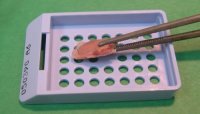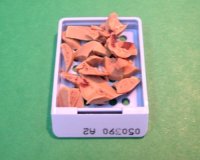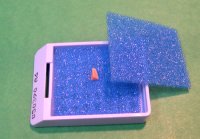Use a sharp blade such as this one, which has a handle with replaceable blades. Handles and blades are available from vendors of histology and pathology supplies.

Tissues must be trimmed to a thickness that will allow them to be completely permeated with paraffin, and to provide the orientation needed. We suggest "thick as a nickel" as a thumb rule. Some mouse organs are small enough that they are best embedded whole.

If there is an area of particular interest, such as a tumor, in the specimen, trim the tissue so that the area of interest is near one surface of the specimen, and place that surface down in the cassette.
Be sure to let the histotechs know if the area of interest is very small to ensure that it is not lost or missed. Be advised that it is very difficult to trim and embed tissues so precisely that it can be determined before sectioning which sections will contain such areas. In such cases it is advisable to request serial sectioning and to save all sections until you're certain you've obtained the information you need. Blocks can always be cut deeper, but discarded sections are gone forever.

Don't place too many tissues in the cassette. Overcrowding can inhibit proper processing, and it isn't possible to get that many tissues positioned in the block for good sectioning anyway. This one should have about 1/2 or 2/3 of the amount of tissue shown.
As a general rule, place tissues of similar consistency together. For example, don't place tough tissues such as skin in the same cassette as soft tissues such as spleen or brain. If the tissues vary greatly in consistency, they may not all section well.

If the tissue is very small, biopsy pads can be used to help prevent the specimen from being lost. Biopsy cassettes with fine screens also are available. Biopsy pads also can be used to prevent samples of skin and hollow organs from curling during fixation, but care must be taken not to compress or distort the tissue.
In general, biopsy pads should not be used with larger tissue samples. However, they can be used to maintain orientation or positioning of trimmed samples, as distortion is of less concern with fixed solid tissues. (See the examples on the Special processing & embedding page.)
